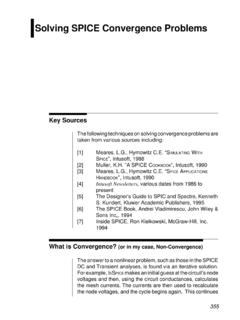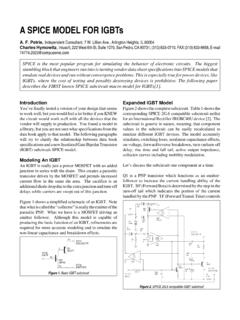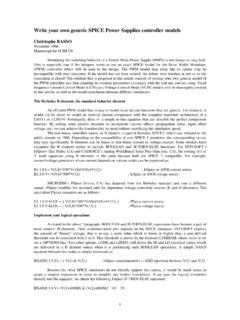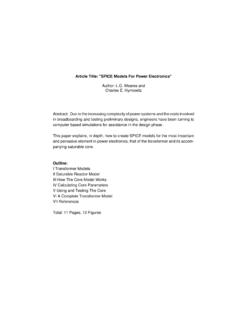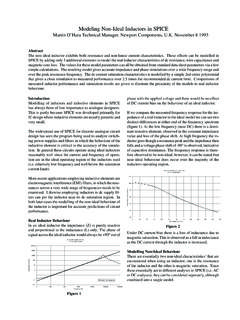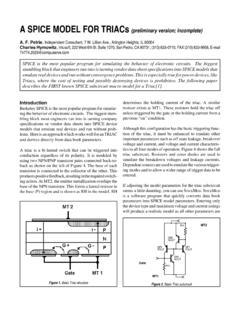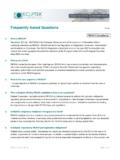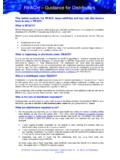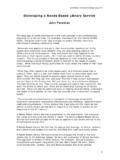Transcription of Average simulations of FLYBACK converters with …
1 Average simulations of FLYBACK converters with SPICE3. Christophe BASSO. May 1996. Within the wide family of Switch Mode Power Supplies (SMPS), the FLYBACK converter represents the preferred structure for use in small and medium power applications such as wall adapters, off-line battery chargers, fax machines, etc. The calculations involved in the design of a FLYBACK converter , especially one which operates in discontinuous mode, are not overly complex. However, the analysis of the impact of the environment upon the system may require a lengthy period of time: ESR variations due to temperature cycles, capacitor aging, load conditions, load and line transients, the effects of the filter stage, etc. must be considered. A SPICE simulator can help the designer to quickly implement his designs and show how they react to real world constraints.
2 The simulation market constantly releases SMPS models, and the designer can rapidly lose himself in the eclecticism of the offer. This article will show how you can benefit from these new investigation tools. Simulating SMPS with SPICE is not a new topic In 1976, R. D. Middlebrook settled the mathematical basis for modeling switching regulators [1]. Middlebrook showed how any boost, buck, or buck-boost converter may be described by a canonical model whose element values can be easily derived. In 1978, R. Keller was the first to apply the Middlebrook theory to a SPICE simulator [2]. At that time, the models developed by R. Keller required manual parameter computation in order to provide the simulator with key information such as the DC operating point.
3 Also, the simulation was only valid for small signal variations and continuous conduction mode. Two years later, Dr. Vincent Bello published a series of papers in which he introduced his SPICE models [3]. These models had the capacity to automatically calculate DC operating points, and allowed the simulated circuit to operate in both conduction modes, regardless of the analysis type (AC, DC or TRAN). Although these models are 15 years old, other models have been introduced since then, our example circuits which have been based upon them will demonstrate how well they still behave. Switching or Average models ? Switching models will exhibit the behavior of an electrical circuit exactly as if it were built on a breadboard with all of its nonlinearities.
4 The semiconductor models, the transformer and its associated leakage elements, and the peripheral elements are normally included. In this case, the time variable t is of utmost importance since it controls the overall circuit operation and performance, including semiconductor losses and ringing spikes which are due to parasitic elements. Because SMPS circuits usually operate at high frequencies and have response times on the order of milliseconds, analysis times may be very long. Furthermore, it is practically impossible to evaluate the AC transfer function of the simulated circuit due to the switch. Average models do not contain the switching components. They contain a unique state equation which describes the Average behavior of the system: in a switching system, a set of equations describe the circuit's electrical characteristics for the two stable positions of the switch/ (es), ON or OFF.
5 The state-space-averaging technique consists of smoothing the discontinuity associated with the transitions of the switch/ (es) between these two states. The result is a set of continuous non-linear equations in which the state equation coefficients now depend upon the duty cycles D and D (1-D). A. linearization process will finally lead to a set of continuous linear equations. An in-depth description of these methods is contained in D. M. Mitchell's book, DC-DC Switching Regulators Analysis , distributed by e/j BLOOM Associates (71147,3274). The general simulation architecture The key to understanding the simulation of SMPS with a SPICE simulator is to first experiment with very simple structures. Figure 1 shows the basic way to simulate an Average voltage- mode FLYBACK converter with its associated components.
6 As a starting point, simply draw a minimum 1. part count schematic: simple resistive load, output capacitor with its ESR, perfect transformer (XFMR. symbol), no input filter, no error amplifier etc. FLYBACK converter model Output transformer Output voltage Out+. In+. COUT. RLOAD. In- Out- Input voltage Duty Cycle ESR. Duty cycle input Figure 1. By clicking on the Average FLYBACK model symbol or simply filling in the netlist file, the working parameters will be entered, the operating switching frequency, the value of the primary power coil, etc. Some recent models require the loop propagation delays or overall efficiency. The parameters for the remaining components are obvious, except for the duty cycle input source. This source will directly pilot the duty cycle of the selected model.
7 By varying the source from 0 to 1V, the corresponding duty cycle will sweep between 0 and 100%. For the first simulation , without an error amplifier, you will have to adjust this source such that the output matches the desired value. This value corresponds to the DC operating point that SPICE needs for its calculations. The correct value can be determined incrementally or via the features in Intusoft's (San-Pedro, CA) IsSpice software. The Interactive Command Language (ICL), is a tremendously powerful language which has been primarily derived from the SPICE3 syntax and allows the designer to dynamically run SPICE. commands without going back and forth from the schematic to the simulator. Below is a brief example of how the previous iteration process could be written: while V(OUT)<=15 ;while the voltage at node OUT is less than or equal to 15V.
8 Tran 1u 100u ;run a TRANSIENT analysis lasting 100us alter @Vduty[dc]=@Vduty[dc]+1mV ;increment the duty source by 1mV steps print mean(V(OUT)) mean(@Vduty[dc]) ;print the output and the duty source Average values end The SPICE simulator will compute the different values and refresh the output windows until the specified conditions are met. At this time, Vduty for the desired output value is known and can be reflected back to the schematic. In order to reduce execution time, and yield a more precise result, you could also run a DC sweep, although this method is less flexible. simulation trick: temporarily replace your large output capacitor with a small value in order to shorten the necessary transient time at every iteration. Small values require fewer switching cycles in order to reach the output target level.
9 The Pulse Width Modulator gain In a voltage-controlled FLYBACK SMPS, the conduction time of the primary switch depends upon the DC voltage that is compared with the oscillator sawtooth, as shown in Figure 2: 2. Comparator Error amplifier VC. output voltage Duty cycle Output VH. D = VC - V . VL VH - V . oscillator sawtooth Figure 2. This circuit can be seen as a box which converts a DC voltage (the error amplifier voltage). into a duty cycle (D). The Average models accept a 1 volt maximum duty cycle control voltage (D=100%). Generally, the IC's oscillator sawtooth can swing up to 3 or 4 volts, thus forcing the internal PWM stage to deliver the maximum duty cycle when the error amplifier reaches this value. To account for the 1 volt maximum input of our Average models, the insertion of an attenuator with 1/(VH-V ) ratio after the error amplifier output is mandatory.
10 For example, if the sawtooth amplitude of the integrated circuit we use is , then the ratio will be: 1 In our simulation schematic, to account for the previous sawtooth peak-to-peak value, we would have to restrict the maximum output value of the error amplifier to volts and limit the lower value to greater than VL. Figure 3 updates the schematic of Figure 1. to duty cycle input GAIN. Attenuation ratio K = Vduty DC 380mV AC 1. Figure 3. Performing AC simulations We now have a functional open-loop system with the correct DC output value. The purpose of the next stage will be to sweep the duty cycle source around its DC steady-state level. This will give us the open-loop AC response of the circuit. The Vduty source keeps its DC statement to provide SPICE with a DC point, but the AC 1 command is added.
